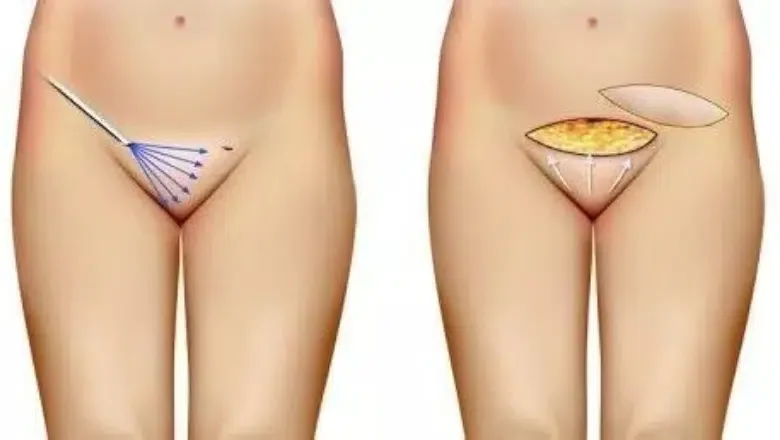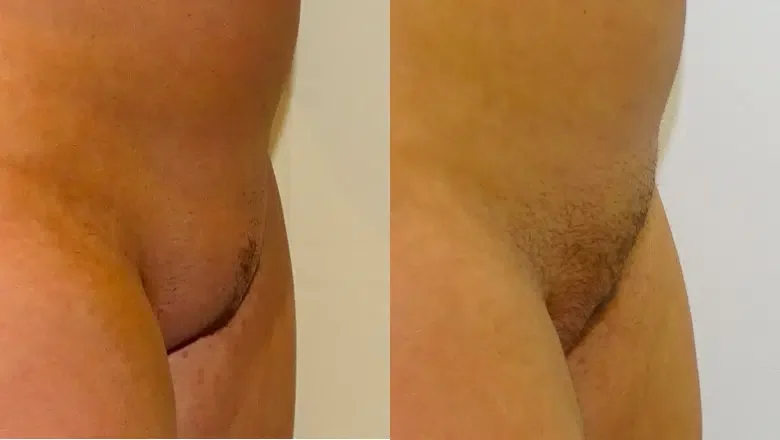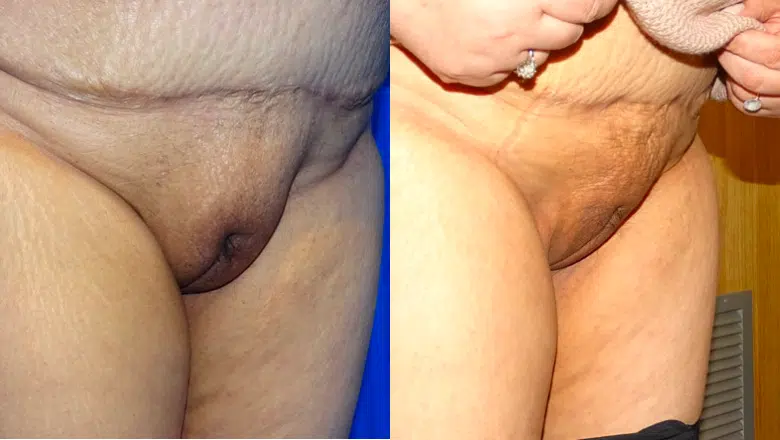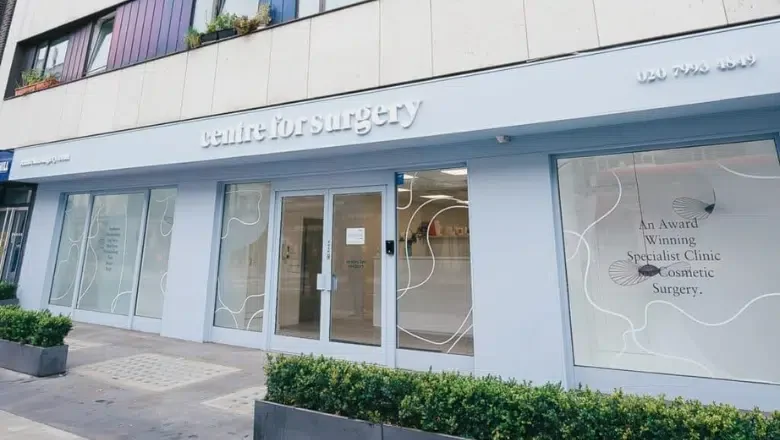Mons Lift (Monsplasty) in London
Mons lift, also known as monsplasty, is a body contouring procedure designed to remove stubborn fat and loose skin from the fatty prominence just above the pubic bone. This localised area of fat is referred to as the mons pubis.
Excess fat may accumulate in the mons pubis as a result of weight gain. Patients who have lost significant weight may develop loose skin over the mons. Mons surgery is a highly effective treatment for removing excess skin and fat, leading to a flatter and less prominent mons pubis.
RELATED: How to get rid of FUPA – Fat Upper Pubic Area
Mons reduction surgery can be carried out using several different surgical techniques, depending on the presenting problem, whether primarily excess fat or excess skin. Patients with skin laxity will require surgical removal of redundant skin. Many patients may have good skin elasticity, and mons pubis liposuction alone is a highly effective treatment for removing localised mons fat. In some cases, these techniques can be combined with liposuction, which is performed first, followed by the removal of excess skin.
For patients who have gained smaller amounts of weight and lost it soon after that, surgical skin excision and liposuction alone may be suitable to enhance the shape and reduce a prominent mons pubis. Patients who are older or who have lost a significant amount of weight will often be left with sagging skin, which hangs down from the mons pubis once mons pubis liposuction has been carried out. Removal of excess skin can then effectively tighten the area.
Mons surgery is the most commonly carried out during an abdominoplasty (tummy tuck) procedure. Tummy tuck surgery is primarily designed to tighten loose skin affecting the lower and upper abdomen, and this often results in a more prominent mons pubis due to fatty bulging tissue once the tummy tuck is completed. Performing a monsplasty at the same time as a tummy tuck means the pubic area can be flattened to the same level as the abdomen.
RELATED: What is the Difference Between a Labiaplasty and a Monsplasty?
What is a Mons Lift?
A mons lift, also known as monsplasty or a pubic lift, is a cosmetic procedure designed to improve the appearance of the mons pubis, which is the rounded, fleshy area located over the pubic bone. This area can become enlarged or saggy due to factors such as weight loss, ageing, pregnancy, or genetics. The excess skin and fatty tissue in the mons pubis can lead to discomfort, hygiene issues, and self-consciousness about one’s appearance, particularly in form-fitting clothing or swimwear.
RELATED: What is a Monsplasty or “Pubic Lift”?
The mons lift procedure aims to restore a more youthful and aesthetically pleasing contour to the mons pubis by removing excess skin and fat and tightening the remaining skin. The result is a smoother, firmer, and more proportionate appearance that can enhance an individual’s self-esteem and comfort.
The procedure can be performed as a standalone operation or in combination with other body contouring surgeries, such as abdominoplasty (tummy tuck), liposuction, or lower body lift. The recovery time and potential risks associated with a mons lift will vary depending on the extent of the procedure and individual factors.
Mons Reduction Before & After Photos
Case 1:
Case 2:
Benefits of a Pubic Lift
Mons pubis reduction is primarily aimed at improving the appearance of the mons pubis area, but may also address functional symptoms in individuals with excessive skin. People who have a prominent mons pubis may have difficulty passing urine and having regular sexual intercourse. This is due to excess sagging skin, which extends downwards as far as the external genitalia, including the urethra. Achieving successful penetration for sexual intercourse is, therefore, much more difficult.
RELATED: Benefits of Monsplasty
Many people find that they are unable to adequately clean themselves in the area due to excessive amounts of loose skin that are present in the area. This could potentially result in skin irritation and the development of bacterial and fungal infections in the area.
Some women may find they have thickened scars in the lower abdominal area due to a previous Caesarean section, and this may result in scar tethering to the underlying muscle layer. The skin beneath the scar remains flexible, allowing it to extend downwards over time, resulting in a prominent-looking mons. People who have lost significant amounts of weight may end up with excessive amounts of loose skin, particularly in the abdomen.
A tummy tuck is most effective for removing loose skin. Mons lift surgery is often combined with a tummy tuck to flatten an excessively prominent mons pubis, which would otherwise look unsightly if a tummy tuck were carried out on its own. People can develop a loss of self-confidence from how they look, and having mons pubis reduction can help restore confidence and improve emotional well-being.
Am I Suitable?
When you have your consultation at Centre for Surgery, your surgeon will carry out a detailed clinical assessment and will consider you suitable for the procedure if you fit the criteria below:
- Good physical and mental health with no chronic medical conditions
- You are unhappy with the appearance of your mons pubis
- You understand what the procedure involves and have realistic expectations of the potential outcome following the procedure.
- Having an overly prominent mons pubis due to a thickened C-section scar
- Difficulty with urination due to excess skin covering the urethra
- A lack of enjoyment during sexual intercourse due to pain and discomfort
- Having excess skin folds makes it difficult to carry out personal care properly, leading to social embarrassment
Mons pubis enlargement results in many people developing unhappiness and low mood. This can eventually result in depression and may affect emotional well-being. Mons lift surgery is an excellent solution to correcting excess skin or fat affecting the mons pubis to restore self-confidence fully.
Mons Lift Procedure
Mons reduction surgery is designed to reduce the prominence of a prominent mons pubis, which improves its overall appearance. Some people may have functional symptoms, including difficulty in having sexual intercourse and may suffer from personal hygiene issues related to passing urine. There are two main options for performing mons reduction.
RELATED: How is a Monsplasty Done?
Both procedures take approximately one to two hours to complete. Mons lift surgery is performed as a day case, and you will be able to return home on the same day as your surgery.
Mons pubis liposuction
This is the most suitable technique for people who primarily have excess fat in the mons pubis and good skin elasticity. Mons pubis liposuction can be performed under either a local anaesthetic alone, or you can choose to have a general anaesthetic known as TIVA anaesthesia. This will vary depending on the individual and whether you want to be awake during the procedure. Centre for Surgery uses the gold standard liposuction method, known as PAL lipo, often combined with Ultrasound-assisted liposuction.
Small incisions are made to permit the insertion of small-diameter liposuction cannulas. Power-assisted liposuction is used to gently break up fat cells before removing them with suction. Liposuction is excellent for removing localised pockets of fat but is not a suitable treatment for getting rid of excess skin. Patients with loose skin as part of the ageing process or from massive weight loss will require surgical skin excision to tighten the mons pubis.
Mons pubis reduction with skin excision
Patients who have developed loose skin as a result of the ageing process or from significant weight loss are often left with loose, sagging skin in the mons pubic area.
When patients are overweight, the excess fat stretches out the overlying skin envelope. When weight loss occurs, the loose skin does not return to its original tightness due to a loss of collagen and elastin, both of which are responsible for conferring skin tightness.
Some patients may have minimal excess fat and have primarily loose skin. Mons lift can be carried out with surgical excision alone to eliminate excess skin. The mons pubis is then effectively tightened by stitching to the deeper muscle layer and adjacent healthy skin.
Recovery after Mons Reduction Surgery
After the procedure, ensure that someone is available to care for you and provide any necessary support on the first post-operative day. Our team will closely monitor you to ensure everything is progressing smoothly. Bruising and swelling in the area are normal, along with slight pain or discomfort. If you experience severe pain or extreme numbness in the affected area, please get in touch with your doctor as soon as possible.
RELATED: What is the Recovery Process for a Monsplasty?
You can resume your normal activities 4 to 6 weeks after the procedure. The discomfort in the area can be controlled with the help of medication prescribed by your surgeon. After three to four weeks, the swelling should be less noticeable. A compression garment should be worn until the doctor decides it is safe to remove it. After several months, the area will be completely healed.
How Much Does a Mons Lift Cost?
Here at Centre for Surgery, we offer in-depth consultations directly with a surgeon and offer 0% finance to help you manage the cost of your procedure.
Having mons lift treatment under general anaesthetic starts from £3495. You will receive an accurate quotation from your dedicated patient coordinator once you have had a face-to-face consultation with the surgeon.
What is included in the cost of my treatment?
Mons lift prices include a preoperative assessment with one of our expert nurses to make sure you are optimally prepared for surgery. The procedure cost includes having treatment at our state-of-the-art Baker Street clinic in central London. You will also have access to our post-operative nursing team 24/7 for any questions or concerns you may have. Our postoperative aftercare has been described as ‘outstanding’ by the Care Quality Commission.
Why Choose Centre for Surgery
Centre for Surgery is home to some of the most experienced consultant plastic surgeons in the UK. We are renowned for our expertise in all forms of body contouring surgery. When you come to see one of our surgeons, you can be assured of receiving the very best medical care from highly qualified experts.
Experienced Surgeons
Centre for Surgery is home to a highly skilled team of plastic and reconstructive surgeons. Our surgeons are not only renowned for their technical expertise but also for their compassionate and patient-focused approach. They remain up-to-date with the latest techniques and advancements in the field to provide the most effective and safest procedures for our patients.
Comprehensive Consultations
We believe in comprehensive consultations that allow ample time for discussion and in-depth understanding of the patient’s concerns, expectations and the procedure itself. Our consultations are not rushed; they are designed to make sure you feel heard, respected, and confident about your treatment plan.
Patient Safety
Patient safety is our utmost priority. We adhere strictly to guidelines and safety protocols established by medical associations. Our modern and well-equipped facility includes state-of-the-art operating rooms and recovery suites, further ensuring a safe environment for all procedures.
Aftercare Services
Our commitment to patient care continues well after the surgery. We provide exceptional aftercare services, making sure you have access to post-operative appointments and medical assistance whenever needed. We believe in building long-term relationships with our patients and being there for you every step of the way.
Personalised Treatment Plans
We understand that every patient is unique with individual needs and aesthetic goals. Hence, we offer bespoke treatment plans tailored to meet your specific requirements. We ensure that your treatment plan aligns with your goals, lifestyle, and medical history to deliver optimal results.
Transparent Pricing
We believe in transparent and honest pricing, with no hidden costs. We ensure our patients understand the cost of their procedures fully before moving forward.
Ethical Approach
We are committed to an ethical approach in all our practices. We will not recommend unnecessary procedures or treatments. Our goal is to help you make an informed decision about what’s best for your body and health.
Comfort and Privacy
We take extra care to provide a comfortable and private environment for all our patients. From your initial consultation to your recovery period, we strive to make your experience as relaxing and confidential as possible.
FAQs
-
What is the mons pubis?The mons pubis is the area that is located over the pubic bone and often appears as a mound consisting primarily of fat. Both men and women have a mons pubis, although it is often more pronounced in women.
The mons pubis resembles a triangular shape, with the base positioned uppermost against the lower abdomen. Hair follicles typically cover the area. The padded nature of the mons pubis is thought to facilitate satisfactory sexual intercourse without discomfort. -
What is FUPA and what does it look like?FUPA is an acronym that stands for Fat Upper Pubic Area. This term is commonly used to describe a deposit of fatty tissue and loose skin located in the lower part of the abdomen, specifically around or above the pubic region. It may also be referred to as a panniculus in medical terminology.
The appearance of a FUPA can vary greatly from person to person, based on factors such as body type, age, weight changes, and whether the person has given birth. In some cases, it may appear as a slight bulge or pouch that is more noticeable when wearing tight clothing. In others, it may be larger and more prominent. It's important to note that the presence of a FUPA is common and normal, and it doesn't necessarily indicate a medical issue or a need for weight loss. However, some people may choose to pursue surgical options, such as a lower body lift or a tummy tuck, for aesthetic reasons or for comfort. -
Why do I have a FUPA if I’m skinny?Even if you have a slim or lean overall body shape, it's possible to have a FUPA (Fat Upper Pubic Area). There are a few reasons why someone who appears to be skinny may still have excess fat in the pubic region:
Genetics: Your genetics play a significant role in determining your body's fat distribution. Some individuals may naturally carry more fat in certain areas, including the upper pubic region, regardless of their overall body weight.
Hormonal Factors: Hormonal changes and imbalances can affect fat distribution in the body. Certain hormonal conditions, such as polycystic ovary syndrome (PCOS), can contribute to increased fat accumulation in the pubic area.
Stubborn Fat Deposits: The pubic area is prone to stubborn fat deposits that are resistant to diet and exercise. These fat cells may be more resistant to being metabolised or broken down, leading to persistent fat in the upper pubic region.
Weight Fluctuations: Even if you maintain a generally low body weight, fluctuations in weight over time can affect fat distribution. If you have experienced weight gain and loss cycles, it's possible for fat to accumulate in the pubic area, which may not disappear even with weight loss. -
What causes FUPA?Various factors can contribute to the development of a FUPA, otherwise known as a Fat Upper Pubic Area. These include:
Genetic Predisposition: Your genetic makeup plays a significant role in dictating where your body stores excess fat. Some individuals may naturally carry extra weight in the upper pubic area due to their genetic predisposition.
Rapid Weight Fluctuations: Sudden or dramatic changes in weight, either gaining or losing, can lead to the development of a FUPA. When weight is gained rapidly, the body often deposits fat unevenly, and the upper pubic area is a common site for such accumulation. On the flip side, losing weight too quickly can result in loose, sagging skin in the region, giving the appearance of a FUPA.
Pregnancy: During pregnancy, the body undergoes significant changes to support the growing fetus. Fat is stored around the abdominal and pubic areas to cushion the uterus and provide energy reserves. After childbirth, especially in the case of multiple pregnancies or C-sections, some women may find it challenging to lose this excess weight and skin. This often results in a persistent FUPA, even with regular exercise and a balanced diet.
Aging: As the body ages, skin loses its elasticity, and fat distribution changes, which can lead to the development of a FUPA. Hormonal changes associated with aging can also contribute to increased fat storage in this area.
Sedentary Lifestyle: Lack of physical activity and a sedentary lifestyle can lead to weight gain and fat accumulation in various areas of the body, including the upper pubic area. -
How to get rid of pubic fat?Addressing excess pubic fat or FUPA involves both lifestyle changes and potentially surgical interventions. Here are a few strategies to consider:
Diet and Exercise: The foundation of any fat loss endeavour is a well-balanced diet and regular exercise. Incorporating a diet rich in lean proteins, whole grains, fruits, and vegetables, coupled with regular physical activity, can aid in overall weight loss, which may also help reduce the size of a FUPA. However, it's important to note that targeted fat loss or "spot reduction" isn't scientifically proven.
Targeted Exercise: Certain exercises can help strengthen and tone the muscles in the lower abdominal region, potentially improving the appearance of a FUPA. These exercises could include pelvic tilts, reverse crunches, and planks.
Surgical Intervention: For persistent FUPA that isn't responsive to diet, exercise, or non-surgical treatments, surgical intervention might be considered. This could include a monsplasty or a lower body lift, which can remove excess skin and fat in the pubic region, providing a more contoured appearance. -
What are the causes of an excessively large mons pubis?People who have an oversized mons pubis most commonly develop it as a result of weight gain. Excess fat accumulates in the mons pubis, which results in a prominent bulging appearance and with the overlying skin being stretched out. When weight loss occurs, the loose skin cannot return to its original level of tautness due to a loss of skin elasticity leading to a saggy mons pubis. Sometimes genetics can contribute to the development of excess fat having a tendency to accumulate in the mons pubis.
Women may commonly develop a large mons pubis as a result of a previous C-section. Sometimes C-section scars can be firmly apparent to the underlying muscle layer resulting in bulging of surrounding tissues including the mons pubis and lower abdomen.
Hormonal fluctuations can result in excess fat developing in the mons pubis due to high levels of oestrogen which explains why women are more likely to develop enlargement of the mons pubis. -
Can a mons lift be combined with other procedures?Mons pubis reduction is most commonly carried out as part of a tummy tuck (abdominoplasty) procedure or even as part of a more comprehensive mummy makeover surgery. Mummy makeover surgery at Centre for Surgery involves restoring a woman to her pre-pregnancy body shape with a breast lift or breast implants combined with liposuction and tummy tuck.
Many women may combine a mons lift procedure with cosmetic gynaecology treatments, including labiaplasty, vaginoplasty or a vaginal rejuvenation procedure. -
What are the benefits of combining mons surgery with a tummy tuck?Tummy tuck (abdominoplasty) commonly involves performing a mons lift at the same time.
Significant weight loss whether from diet and exercise or bariatric surgery, results in extra loose skin that may sag with time. Abdominoplasty surgery can effectively tighten loose abdominal skin and surgically repair weakened abdominal muscles resulting in a firmer and more sculpted abdomen. The mons pubis may then appear more prominent, and surgeons may carry out mons reduction in combination with a tummy tuck to reduce the size of a prominent mons pubis.
The optimum treatment options will be discussed at your Mons lift consultation in London. -
Can I have a tummy tuck alone without Monsplasty?Yes, it's entirely possible to have a tummy tuck (abdominoplasty) without also having a monsplasty. A tummy tuck is primarily designed to remove excess skin and tighten the muscles in the abdominal area, while a monsplasty specifically addresses excess skin and fat in the mons pubis region, the area just above the pubic bone.
The choice to have these procedures done separately or together depends on the individual patient's goals and the surgeon's professional advice. Some patients may find that a tummy tuck alone can meet their aesthetic goals, while others may benefit from the combined procedure. Keep in mind that while combining the procedures can have the benefit of a single recovery period, it also comes with increased complexity and potential risk. -
What is mons lift recovery like?You should expect full healing and recovery to take roughly six weeks from mons pubis reduction surgery. In the early postoperative period, it is normal to have a mile degree of bruising and swelling and any mild discomfort can be easily controlled with over-the-counter painkillers. The symptoms may last for up to 2 weeks after the procedure. We would recommend you stay mobile in the first few days after the procedure to reduce the risk of blood clots. Patients can return to light work duties after one week, although some people may need to take longer periods of time off as they have a more physically demanding occupation.
You should avoid lifting heavy objects or children during the first four weeks after surgery. Strenuous exercise, including gym workouts, can be restarted after four weeks but you should make sure to check with your surgeon first.
If you are combining mons reduction surgery with a tummy tuck, the overall recovery time may differ. -
What are the potential risks and complications of mons lift surgery?Compared with a tummy tuck, mons reduction is a very safe procedure with minimal risk of complications due to its minimally invasive nature. Liposuction risks are limited as the area where liposuction is performed is very small. The most common side effects after this procedure include a mild amount of bruising, swelling, paraesthesia and a small amount of fluid leakage due to the local anaesthetic used during treatment. Liposuction is a very safe procedure, although certain recognised risks include skin rippling leading to uneven results, haematoma formation, long-lasting numbness, skin discolouration, seroma or visceral organ damage.
Wound infection is a small risk associated with any type of procedure that makes an incision into the skin. Your surgeon will take precautions to minimise the risk of these complications developing. -
Will I have scars after mons reduction surgery?Mons pubis liposuction is a procedure with minimal scarring due to the tiny incisions used for the liposuction cannulas. Mons reduction with surgical excision involves a small incision made horizontally just above the prominence of the mons pubis. This scar heals very well and is well-concealed by virtually all styles of clothing. In rare cases, particularly in people who have lost weight leading to loose skin, your surgeon may need to extend the incision vertically upwards to tighten the area effectively.
If you are concerned about the appearance of your scar, this can can be improved by following the surgeons post-operative instructions in full, keeping well hydrated during the recovery phase, using silicone gel sheets when the incision has healed and by seeing our aesthetic practitioners for laser or microneedling treatment. -
Where can I recommence sexual intercourse after mons surgery?Patients should avoid sexual intercourse for at least four weeks after the Mons reduction surgery. The mons pubis has a shock absorber effect during sexual intercourse and if the area is still tender or sore, this can impede healing leading to a delayed recovery. Sexual intercourse should only be restarted once you have made a full recovery. If you experience any pain or discomfort during sexual intercourse, you should refrain from further sexual activity until your symptoms have resolved completely.
What To Expect
Consultation
Your mons lift consultation will take place at our specialist cosmetic surgery clinic in Marylebone with an expert consultant plastic surgeon. The consultation will take approximately 45 minutes for a comprehensive clinical assessment. As part of the assessment, your surgeon will enquire about the results you are hoping to achieve from having mons pubis reduction and will explain what the procedure involves. A discussion will also take place on the potential risks and complications of surgery and what to look out for during the recovery period.
Having realistic expectations of what a mons lift can achieve will give the best possible chance of achieving optimum results. Feel free to ask any questions you may have about the treatment and what it involves. You may wish to come prepared with a list of questions before you attend your consultation. Once your surgeon has taken a medical history
including any medicines you may be taking, a physical examination will be carried out and photographs will be taken.
Your surgeon will then discuss your suitability for the procedure and if you fulfil the criteria, we would recommend you take two weeks to reflect on all aspects of the procedure before getting in contact with us to book your mons lift surgery.
Before your procedure
Once you have booked for the procedure, our preoperative nursing team will send you a comprehensive information pack which includes making sure you comply with the following to minimise the risk of complications occurring:
- if you are a smoker you should stop at least four weeks before surgery and ideally six weeks and continue this for at least six weeks after the procedure. Smoking should be avoided for a minimum of 72 hours before the surgery minimise the risk of anaesthetic complications.
- certain medications which may increase the risk of bleeding should be stopped and these include aspirin, anti-inflammatory drugs and over the counter herbal supplements for at least one week before surgery.
- you should avoid alcohol for at least three days before surgery as alcohol both interferes with the anaesthetic and can impair wound healing.
- make sure you arrange for a responsible adult escort to collect you once the procedure is complete and to drive you home and look after you for at least the first 24 hours after your surgery.
You must adhere to the pre-operative fasting requirements if your procedure involves anaesthetic or sedation. No food should be consumed for six hours before surgery and only sips of clear fluid are allowed for up to 2 hours before your surgery time.
Clear fluids include still water, black tea and black coffee.
On the day of your surgery
Your mons surgery procedure Will take place at our state-of-the-art clinic in Marylebone, Baker Street. The anaesthetist will first put you to sleep using a general anaesthetic for the duration of the procedure. In some cases, you may choose to have the procedure under a local anaesthetic where you will remain awake but comfortable throughout the procedure.
Mons pubis liposuction involves the insertion of a small cannula into the fatty mons pubis to gently break up the fat cells prior to removing them with vacuum suction.
Surgical skin excision involves the surgeon making a small horizontal incision just above the mons pubis. This part of the body is well covered by items of clothing. The skin is gently removed and the skin is then carefully closed with absorbable stitches. Using absorbable stitches means you do not have to have them removed at your post-operative review appointment.
After the mons lift surgery, you will spend time recovering in our day surgery ward. It is normal to feel a little dizzy and drowsy, to begin with but this rapidly wears off after a couple of hours. Once you are eating and drinking, have minimal pain and have been to the toilet you will be discharged by our nursing team and postoperative instructions will be explained to your adult caregiver.
Mons lift recovery
Once the procedure is complete and you begin to wake up, any discomfort will be mild and easily controlled with over-the-counter painkillers prescribed to you by your surgeon. The area may appear bruised and swollen for the first two weeks after surgery although you should notice the difference from the procedure immediately.
During the first couple of days after mons surgery, try to stay reasonably mobile around the house and keep well hydrated to reduce the risk of blood clots forming. You should avoid lifting heavy objects or young children and most people can turn to an office-based role after one week. You should avoid getting your incisions wet for the first few days after surgery and you may take a bath after four weeks. Most people will be allowed to restart exercise including gym activities after six weeks. So recovery after months lift is expected by the six-week stage.
During your recovery period, you will have access to our post-operative nursing team with the supplied contact details and they are available to answer any questions or concerns you may have.
Getting the best results after mons reduction means following all the post-operative care instructions given to you by your surgeon. If you fail to follow the instructions, your healing and recovery may be compromised leading to adverse effects on the final results of surgery.














